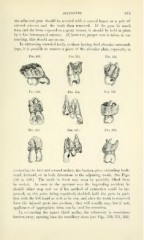Page 615 - My FlipBook
P. 615
ACCIDENTS. 613
the adherent gum should be severed with a curved lancet or a pair of
curved scissors and the tooth then removed. If the gum be much
torn and the bone exposed to a great extent, it should be held in place
by a few interrupted sutures. If, however, proper care is taken in ex-
tracting, this should not occur.
In extracting crowded teeth, or those having frail alveolar surround-
ings, it is possible to remove a piece of the alveolar plate, especially in
Fig. 550. Fig. 551. Fig. 552.
Fig. 553. Fig. 554. Fig. 555.
Fig. 557. Fk;. 558.
extracting the first and second molars, the broken piece extending back-
ward, forward, or in both directions to the adjoining tooth. (See Figs.
550 to 558.) The tooth in front may even be partially lifted from
its socket. As soon as the operator sees the impending accident he
should either stop and see if his method of extraction could be im-
proved, or, this point being negatively decided, hold the parts in posi-
tion with the left hand as well as he can, and after the tooth is removed
force the injured parts into position ; they will usually stay, but if not,
appliances of appropriate form can be used for retention.
Ill extracting the upper third molar, the tuberosity is sometimes
broken away, opening into the maxillary sinus (see Figs. 550, 551, 552,


